This renovated bistro-style dining environment focuses attention on the culinary staff and their creations while inviting employees to relax in spaces that encourage community building.
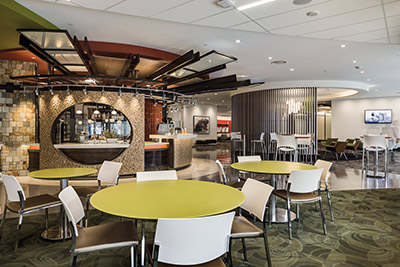 Diners sitting at the round tables and high-tops can watch smoothie preparation at Bean Counter and see the conference center. The slatted divider separates the dining area from the conference area.With more than $530.3 billion in assets under management, The Principal Financial Group (The Principal) serves 19.9 million customers worldwide. This global investment company's many accolades include high rankings in surveys such as Computerworld's "2015 Best Places to Work in IT," based on a comprehensive questionnaire regarding company offerings in categories such as benefits, career development, training and retention. The Principal also ranks 63rd of 503 companies in Forbes' 2015 "America's Best Employers."
Diners sitting at the round tables and high-tops can watch smoothie preparation at Bean Counter and see the conference center. The slatted divider separates the dining area from the conference area.With more than $530.3 billion in assets under management, The Principal Financial Group (The Principal) serves 19.9 million customers worldwide. This global investment company's many accolades include high rankings in surveys such as Computerworld's "2015 Best Places to Work in IT," based on a comprehensive questionnaire regarding company offerings in categories such as benefits, career development, training and retention. The Principal also ranks 63rd of 503 companies in Forbes' 2015 "America's Best Employers."
In order to remain competitive and to attract and retain top talent to its organization, the company embarked on a phased five-year project called Campus Blueprint. "This forward-thinking workspace design includes facilities and the entire environment," says Brad Meister, The Principal's supplier manager. Five of the campus's eight buildings are undergoing renovation. Buildings are changing floor by floor from a dated work setting to a contemporary environment in which some of the employees don't have assigned desks but rather can work at any available desk located in strategic mobile neighborhoods or community spaces such as the new Café 750. The project also includes introducing kitchenettes and redesigning of lobbies and conference rooms as well as the revitalizing the campus's foodservice for employees, guests and the company's clients.
The first of three foodservice transformations is Café 750. The second will bring in a nationally branded bakery café in 2017, and the third will renovate the largest, more traditional-style café in 2018. "We want foodservices that complement each other," Meister says.
 Curved shapes allowed designers to fit stations within the designated space. Above, countertop seating contains networking capabilities for employees to work remotely. Guests move from left to right at My Dish to select their food items and pay.Café 750, located at 750 Park Street and named by employees during a contest, is accessible not only by employees working in the building in which it resides but also by employees who walk through the skyways and tunnels connecting all the buildings.
Curved shapes allowed designers to fit stations within the designated space. Above, countertop seating contains networking capabilities for employees to work remotely. Guests move from left to right at My Dish to select their food items and pay.Café 750, located at 750 Park Street and named by employees during a contest, is accessible not only by employees working in the building in which it resides but also by employees who walk through the skyways and tunnels connecting all the buildings.
"Café 750 offers a fresh, local and sustainable higher-end option that is more like the brick-and-mortar restaurants found in the nearby downtown area, which is within walking distance of the campus," says Mark Spinelli, director of marketing and innovation deployment for Sodexo, which provides foodservice and catering services for The Principal.
The extensive renovation required a transformation of the dining experience from a cafeteria line-based experience designed in the 1990s into an interactive and engaging restaurant-style space that The Principal and its employees will use throughout the workday for more than just dining.
"We brought the action of the kitchen to the fore via an open concept, while breaking some of the negative stereotypes of corporate dining," says Angela Grasso Kehoe, CID, director of interior design at Connor Architecture.
Design Challenges and Solutions
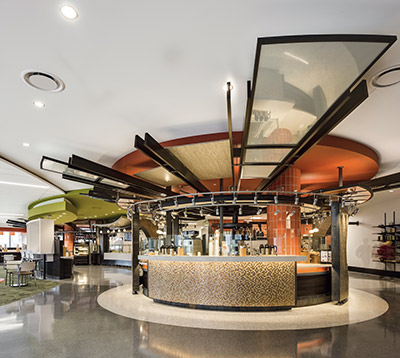 When entering Café 750, guests first see the venue’s coffee bar, Bean Counter.A modern interpretation of a classic bistro, the café concept is organized around a centralized, open show kitchen containing a broad array of cooking equipment and culinary tools to allow for a tremendous variety of menu options and serving styles within a single holistic cooking environment.
When entering Café 750, guests first see the venue’s coffee bar, Bean Counter.A modern interpretation of a classic bistro, the café concept is organized around a centralized, open show kitchen containing a broad array of cooking equipment and culinary tools to allow for a tremendous variety of menu options and serving styles within a single holistic cooking environment.
"The open kitchen concept created a seamless interactive experience between our chefs and guests," says Jon D. Broughton, Sodexo's senior marketing manager. "Now guests can witness the real culinary talent and skills that go into the presentation of their food."
In addition to the open kitchen centerpiece, the dining environment features large and small neighborhoods that are either open or enclosed. This includes some quiet spaces and other more vibrant and energetic areas that can accommodate many guests. Seating options include high-tops, countertops, banquettes, booths, two-, four-, six- and eight-tops, and comfortable lounge chairs. The multiple seating choices allow for comfort and flexibility and help to create a more social space. The venue integrates with an adjacent employee conference center.
"The neighborhood concept also creates a diverse scale of spaces for meeting and informal gatherings of staff and visitors in off-peak hours, which is important for a social, community-building environment," Grasso Kehoe says. "The diversity of the shapes and sizes of the space allows for a variety of events, from meetings to informal gatherings, to occur within the space simultaneously."
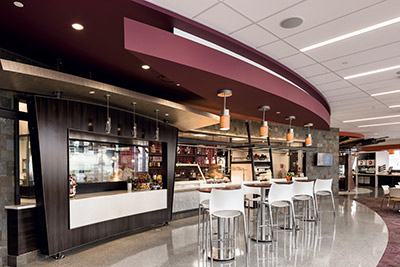 Seating includes upholstered booths at the window wall, round four-tops and high-tops. The structure over the booths includes various LED pendants.Shaped like an acute triangle, the building had no walls that were set at 90-degree angles with which to align the various elements of the space. "We used the servery millwork as the centerpiece of the space with curves and circular stations that fit into the triangular floorplate to carve out negative space for seating neighborhoods around the building perimeter," Grasso Kehoe says.
Seating includes upholstered booths at the window wall, round four-tops and high-tops. The structure over the booths includes various LED pendants.Shaped like an acute triangle, the building had no walls that were set at 90-degree angles with which to align the various elements of the space. "We used the servery millwork as the centerpiece of the space with curves and circular stations that fit into the triangular floorplate to carve out negative space for seating neighborhoods around the building perimeter," Grasso Kehoe says.
Keeping the servery in the center, the site of the original kitchen, helped reduce the need for demolition and planning of new equipment utilities in difficult-to-reach locations. "This allowed us to create a focal point in the center that feels like a series of gearworks for the remainder of the space and allows users to turn about," Grasso Kehoe says.
Another feature contributing to efficiency and access is the set of four self-ordering tablets located at the café entrances where people can order and pay for their meals before going to a station to pick them up.
Menu Production
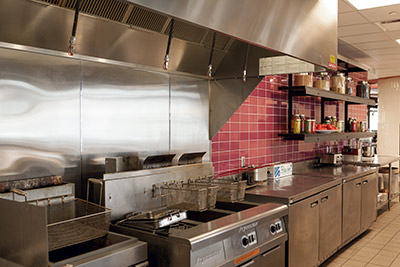 The back line of The Grille includes fryers, refrigeration and shelving.After food arrives at a loading dock on the lower level, staff place deliveries into one walk-in cooler that stores produce, another walk-in cooler that holds meat and dairy and a walk-in freezer. Staff from each Café 750 station come to the lower-level storage to select food they need and transport it upstairs on carts via a dedicated service elevator. Each station has undercounter reach-in refrigerators, and Bean Counter contains a reach-in freezer for frozen yogurt and sherbet.
The back line of The Grille includes fryers, refrigeration and shelving.After food arrives at a loading dock on the lower level, staff place deliveries into one walk-in cooler that stores produce, another walk-in cooler that holds meat and dairy and a walk-in freezer. Staff from each Café 750 station come to the lower-level storage to select food they need and transport it upstairs on carts via a dedicated service elevator. Each station has undercounter reach-in refrigerators, and Bean Counter contains a reach-in freezer for frozen yogurt and sherbet.
Culinary staff at each station prepare mise en place for the day's menu, which features fresh, made-to-order foods. Each station contains refrigerators, interchangeable hot/cold wells, refrigerated rails and grab-and-go airscreen coolers with snacks and bottled beverages so customers can supplement their purchases or the meals they bring from home. Add-on snacks and bottled beverages are also displayed at each of these themed stations adjacent to the two POS areas. "Guests can walk up and pay at the stations, which is quicker for them and eliminates the need for a bank of cash registers in the space," says Andrew Meek, Sodexo's executive chef.
 The checkout area at The Grille includes a backlit stained glass overhang in a steel structure. A built-in merchandiser organizes snack items at the register."When planning for the café, we did a lot of customer surveying," says Broughton. "Employees were looking for authentic, variety and speed of service. We give them all of that. We selected the equipment that allows the culinary staff to prepare a lot of variety. We wanted equipment that was flexible and could take a beating. We need a lot of BTUs and didn't want many bells and whistles. Quick disconnects also contribute to flexibility and allows for menu adaptation in the future. The planning and equipment has worked well."
The checkout area at The Grille includes a backlit stained glass overhang in a steel structure. A built-in merchandiser organizes snack items at the register."When planning for the café, we did a lot of customer surveying," says Broughton. "Employees were looking for authentic, variety and speed of service. We give them all of that. We selected the equipment that allows the culinary staff to prepare a lot of variety. We wanted equipment that was flexible and could take a beating. We need a lot of BTUs and didn't want many bells and whistles. Quick disconnects also contribute to flexibility and allows for menu adaptation in the future. The planning and equipment has worked well."
The Grille station contains a glass display case with cooked-to-order proteins. While lunch service remains the main focus here, this station does serve a full à la carte breakfast menu and prepared-to-order omelets. At lunch, staff prepare sustainable, seasonal fish and hand-formed grass-fed burgers, steaks and pork chops from locally sourced beef and pork.
Staff face customers while assembling ingredients sitting in a refrigerated rail and on stainless steel make counters before cooking them on a griddle or charbroiler. Two fryers turn out fresh-cut french fries, hand-battered onion rings and hand-cut chicken strips and catfish strips on occasion.
"This space was positioned in the north side to make use of hood ductwork from the existing kitchen," Grasso Kehoe says.
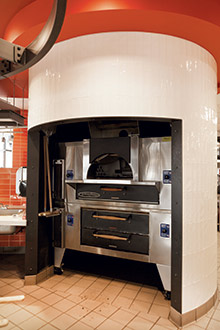 The hearth oven at Oven Fired cooks pizzas and entrées and features hand-carved, extra-large subway tiles. Flat-stock steel at the opening to the oven is both attractive and functional as it provides corner guards and wall protection.Open primarily during lunch, Oven Fired sits at the midpoint of the space creating a visual anchor point. Its key feature, a high-temperature, hearth pizza oven adds an element of entertainment as well as practical function. Staff use this key piece of cooking equipment to bake pizza, calzones, stromboli, and pasta dishes such as mac and cheese. In addition, culinary staff also use the oven to roast scallops for catering menus and roast chickens for salads. In the center of the circular prep space, staff prepare hand-stretched dough, dress pizzas, and prepare mise en place for the other menu items.
The hearth oven at Oven Fired cooks pizzas and entrées and features hand-carved, extra-large subway tiles. Flat-stock steel at the opening to the oven is both attractive and functional as it provides corner guards and wall protection.Open primarily during lunch, Oven Fired sits at the midpoint of the space creating a visual anchor point. Its key feature, a high-temperature, hearth pizza oven adds an element of entertainment as well as practical function. Staff use this key piece of cooking equipment to bake pizza, calzones, stromboli, and pasta dishes such as mac and cheese. In addition, culinary staff also use the oven to roast scallops for catering menus and roast chickens for salads. In the center of the circular prep space, staff prepare hand-stretched dough, dress pizzas, and prepare mise en place for the other menu items.
Lining the perimeter, hot plate warmers display calzones and stromboli. Pendant heat lamps keep dishes warm. "We have the flexibility at stations to offer a self-serve option, though we're not currently using this," Meek says.
Moving around the space counter-clockwise, first up is a beverage area featuring self-serve sodas as well as waters infused with seasonal fruits, cucumber and mint. "The waters are complimentary, and we serve about 30 gallons a day," Andrews says. These offerings help underscore The Principal's focus on wellness.
Sitting across from the beverage area, My Dish features entrees and salads. "This is where the culinary staff gets to be creative," says Broughton. "Depending on the menu, we have the flexibility to turn any of the three dual-temperature wells to hot or cold. And, we've made it as easy on the staff's side of the counter to build plates. Top heat can be turned on and off. Breath guards here are also positioned so they can be used for self-service, though we aren't using this feature now."
Behind the range, undercounter hot cabinets hold dishes such as spanakopita and meatballs. Guests can watch staff prepare entrées and sides on a six-burner range, with flames adding to the visual intrigue. "They get to see the chefs' and cooks' talents," Meek says. "We're not keeping any facet of cooking a secret behind a wall." A convection oven and steamer also sit at this station to add even more menu flexibility.
Two days a week, staff feature an international-themed menu. On a Greek-themed day, for example, the menu included carved boneless leg of lamb, grilled chicken from The Grille and sautéed lemon and oregano shrimp prepared on the six-burner range. The drop-in wells hold spanakopita, oven-roasted Greek potatoes, a spinach and rice dish, braised green beans and warm orzo. On this day, the cold well held Greek panzanella salad and other items such as roasted eggplant spread with pita bread, Mediterranean quinoa and marinated mushrooms. Baklava was the featured dessert. Other themed menus feature cuisine found in Vietnam, Lebanon, Thailand, Japan and India.
During the rest of the week, the station features a selection of up to 28 cold items such as lettuces, quinoa and other grains, beans, brussels sprouts and other vegetables, marinated mushrooms, celery, edamame, cheese and spicy tofu. Entrées might include one carved menu item such as beef brisket and flank steak and another such as a crab cakes. Hand-rolled sushi is another popular offering. Staff use the six-burner range to prepare Szechuan green beans and fried rice. "With this menu approach, we can do visual sauté, a carved item, and use hot boxes for items such as Greek meatballs," Meek says. "This gives us the ability to put out volume and show."
Handcrafted — the café's deli station — is technically an extension of Bean Counter and features a large air-screen cooler displaying up to seven freshly made deli sandwiches, including paninis, wraps and croissants. "We can make custom-made sandwiches, but because of the size of the space, we feature prepared sandwiches." Gluten-free lettuce wraps with hummus, egg salad and ahi tuna are popular as well. A high-speed oven allows staff to quickly warm sandwiches. Also in this area staff use a slicer and panini press. The centrally located steamer and convection oven, along with The Grille's charbroiler, assist in menu preparation of the deli and components for the other stations as well. The station features grab-and-go items throughout the day.
At the main entrance, Bean Counter features Starbucks coffee and other beverages, as well as croissants and fresh-baked pastries, which arrive at 5:30 a.m. from a local artisan bakery and are artfully displayed on bamboo risers. "Sales of coffee, pastries and fresh fruit smoothies can equal café sales," Meek says. Sandwiches also are available in self-serve display units, and staff can toast them in quick-speed ovens.
For cleanup, collection points receive trash, recycled containers and dirty dishes. A main conveyor dish return sits strategically near the exit, while a simpler dish drop sits near the adjacent conference center so guests can conveniently drop off their dishes and serviceware without navigating through the foodservice venue.
The dish return sits within its own circular foyer so it isn't visible to guests and contains a conveyor warewashing machine for china dishes and metal flatware. "We're encouraging green practices as much as possible," Broughton says.
Sustainability and Energy-Saving Features
In terms of sustainable practices, the foodservice operation has its Energy Star–rated equipment where applicable. The space is lit with 100 percent LED lighting. In addition, staff execute a comprehensive recycling plan. "Café 750 is
metered for power and water separately from campus to help coach efficiency with the operator," Meister says.
"Here on campus, we have single-stream recycling for paper, plastics and metals," Broughton says. "Foodservice was the pilot group for this practice in partnership with The Principal." Cardboard recycling is the second stream. Staff place cardboard in a rolling dumpster cart and bring it into a service elevator where it is picked up for recycling. The third stream is the measurement and tracking of preconsumer food waste. "This creates awareness resulting in improved cost savings and a reduced impact on the environment," Broughton adds.
Café staff also track the venue's food waste. "For example, if we're trimming sweet corn, we'll collect the cobs, peels and silk and track it for our Sodexo records," Broughton says. "We're carefully watching our food production, and by tracking we see how much waste we're producing and have been able to cut back as much as 3 to 3.5 percent."
In addition, Sodexo donates food to local shelters and supports The Principal's health and wellness initiatives.
Working in Café 750's open-space servery presents some welcome challenges. "We encourage each culinary person to look at their stations from the customers' perspective and get rid of clutter and anything that's not essential for production," Meek says. "We're constantly on stage, and engaging with guests as part of customer service is also important."
The Principal's Café 750 serves as an example of how dining supports and helps shape the contemporary work environment. "This is not typical corporate dining and will continue to attract a generation that has high and very different expectations of the workplace than previous generations."
Key Players
- Owner: The Principal Financial Group
- Vice President, The Principal: Jed Fisk
- Supplier Manager IV, Corporate Real Estate, The Principal: Bradley K. Meister
- General Manager, Sodexo: Brian Jones; Curtis Downs (now located at another Sodexo account)
- Executive Chef, Sodexo: Andrew Meek
- Retail Manager and Controller, Sodexo: Carol Hilton, Urbandale, Iowa
- District Manager, Sodexo: Shane Klaas, West Des Moines, Iowa
- Regional Culinary Director, Sodexo: Gustavo Vega, Pasadena, Calif.
- Culinary Director, Sodexo: Karin Popovic, Chicago
- Director of Marketing and Innovation Deployment, Sodexo: Mark Spinelli, Houston, Texas
- Senior Marketing Manager: Jon D. Broughton, Ankeny, Iowa
- Lead Architect for Overall Campus: OPN Architects, Des Moines, Iowa
- Architect for Café 750: Connor Architecture, Lexington, Mass.; Mark Connor, founder, principal
- Interior Designer for Cafe 750: Connor Architecture, Binghamton, N.Y.; Angela Grasso Kehoe, CID, director of interior design
- Equipment Dealer: Hockenbergs, Des Moines, Iowa
- Owner’s Representative and Facilities Manager: Jones Lang LaSalle, Des Moines, Iowa
- Construction Manager: DCI Group and Ryan Companies US Inc., both of Des Moines, Iowa
Facts of Note
- Overview: The Principal Financial Group has $530.3 billion in assets under management and serves nearly 19.9 million customers worldwide. It is traded on the New York Stock Exchange under the ticker symbol PFG. In Des Moines, 6,300 employees work in 8 buildings.
- Café 750 Opened: July 2014
- Scope of Project: Renovation to an existing, unused foodservice cafeteria, which includes a reconditioned, minimal production kitchen and dishroom; a servery showcasing culinary employees at work; and a dining room that also serves as a meeting and flexible work space for employees
- Size: 10,780 sq. ft., including approximately 3,000 sq. ft. kitchen/servery and 6,000 sq. ft. dining room
- Seats: 330
- Average Check: $3.38, breakfast; $5.99, lunch; $3.11, afternoon
- Project's Impact on Sales: 20 percent increase for FY 2016
- Transactions: 74,170 since July 2014
- Café Hours: 6:45 a.m. to 1:30 p.m., Monday through Friday
- Bean Counter Hours: 6 a.m. to 4:30 p.m., Monday through Friday
- Menu Specialties: Burgers, bratwurst, vegetable kebabs and hand-cut fries at The Grille; Roman-style pizzas and calzones at Oven Fired; chef-crafted entrees and tossed-to-order salads at My Dish; wraps, paninis and croissant sandwiches, and hand-carved poultry and meats, in Handcrafted (deli); and coffee, other beverages, smoothies and baked goods at Bean Counter
- Staff: Sodexo, 12 FTEs (8 cooks, 3 cashiers, 1 utility person)
- Total Project Cost: $4.3 million
- Equipment Investment: $500,000
- Website: www.principal.com
Meet the Players
 Jon D. Broughton, senior marketing manager for Sodexo, began his culinary arts career in 1987 and honed skills in high-volume restaurants. Joining the Sodexo team in 1995, his positions have included catering manager, retail manager and general manager for Sodexo clients in the Midwest, including the dual role of executive chef and general manager at The Principal from 2008 to 2013. In 2013 he accepted his current position and serves as a marketing and culinary resource to more than 80 accounts in 7 states in Sodexo's Upper-Midwest region.
Jon D. Broughton, senior marketing manager for Sodexo, began his culinary arts career in 1987 and honed skills in high-volume restaurants. Joining the Sodexo team in 1995, his positions have included catering manager, retail manager and general manager for Sodexo clients in the Midwest, including the dual role of executive chef and general manager at The Principal from 2008 to 2013. In 2013 he accepted his current position and serves as a marketing and culinary resource to more than 80 accounts in 7 states in Sodexo's Upper-Midwest region.
 Mark Connor, NCARB, principal architect at Connor Architecture, has practiced architecture, interiors and planning for more than 25 years. He specializes in creating transformative community spaces in a wide range of academic, foodservice, commercial, healthcare, planning and retail projects. His expertise and projects have been awarded and covered in numerous publications.
Mark Connor, NCARB, principal architect at Connor Architecture, has practiced architecture, interiors and planning for more than 25 years. He specializes in creating transformative community spaces in a wide range of academic, foodservice, commercial, healthcare, planning and retail projects. His expertise and projects have been awarded and covered in numerous publications.
 Angela Grasso Kehoe, NCIDQ, is director of interior design at Connor Architecture. Her experience includes large- and small-scale projects with a focus on social space design and foodservice interiors. She defines the interior design direction for the firm's projects by establishing and coordinating the design vocabulary for a cohesive and vibrant solution that is tailor-made for each unique environment.
Angela Grasso Kehoe, NCIDQ, is director of interior design at Connor Architecture. Her experience includes large- and small-scale projects with a focus on social space design and foodservice interiors. She defines the interior design direction for the firm's projects by establishing and coordinating the design vocabulary for a cohesive and vibrant solution that is tailor-made for each unique environment.
 Andrew Meek, executive chef with Sodexo, focuses attention at The Principal on locally sourced foods, sustainable and eco-sensitive approaches to procurement and healthful food preparation. Meek owned and operated a fine dining, five-star restaurant, Sage, that was selected as one of Food & Wine magazine's "Top 100 Farm-to-Table Restaurants." Meek was twice nominated for the James Beard Foundation's "Best of Midwest" chef award.
Andrew Meek, executive chef with Sodexo, focuses attention at The Principal on locally sourced foods, sustainable and eco-sensitive approaches to procurement and healthful food preparation. Meek owned and operated a fine dining, five-star restaurant, Sage, that was selected as one of Food & Wine magazine's "Top 100 Farm-to-Table Restaurants." Meek was twice nominated for the James Beard Foundation's "Best of Midwest" chef award.
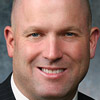 Bradley K. Meister, supplier manager IV, corporate real estate for The Principal, provides oversight for several of the company's supplier relationships including facility management and foodservice. He oversees three café renovations within the campus landscape plan as part of Campus Blueprint. Prior to working in corporate real estate, Meister worked as an analyst on the dental/vision actuarial team. Before joining The Principal in 2008, he was a mortgage professional with Wells Fargo Bank, NA.
Bradley K. Meister, supplier manager IV, corporate real estate for The Principal, provides oversight for several of the company's supplier relationships including facility management and foodservice. He oversees three café renovations within the campus landscape plan as part of Campus Blueprint. Prior to working in corporate real estate, Meister worked as an analyst on the dental/vision actuarial team. Before joining The Principal in 2008, he was a mortgage professional with Wells Fargo Bank, NA.
 Mark Spinelli, director of marketing and innovation deployment, Sodexo, joined the company in 1994. Prior to his current position he was senior retail marketing manager and held various other operation-based positions in business and industry (B&I) and universities in Texas and California. Spinelli and his team use proprietary consumer research tools to design and implement innovative culinary and marketing programs for B&I clients in the Western and Southeast United States.
Mark Spinelli, director of marketing and innovation deployment, Sodexo, joined the company in 1994. Prior to his current position he was senior retail marketing manager and held various other operation-based positions in business and industry (B&I) and universities in Texas and California. Spinelli and his team use proprietary consumer research tools to design and implement innovative culinary and marketing programs for B&I clients in the Western and Southeast United States.




